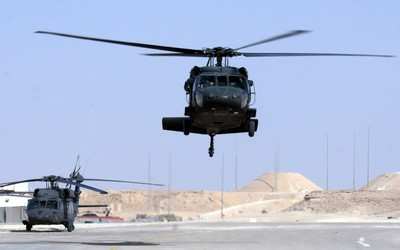Fri, Oct 09, 2009
Full Cockpit View, Other Aircraft Information In Helmet
Display
 The U.S. Army has awarded Raytheon
a $13 million contract to develop additional sensor prototypes for
the Advanced Distributed Aperture System, which gives helicopter
pilots 360-degree situational awareness.
The U.S. Army has awarded Raytheon
a $13 million contract to develop additional sensor prototypes for
the Advanced Distributed Aperture System, which gives helicopter
pilots 360-degree situational awareness.
The award is the first extension of the Joint Capability
Technology Demonstration contract, initially funded in September
2008.
The Army launched the ADAS program to assist pilots flying at
low altitudes. The original system provides up to six infrared
sensors and a combined helmet display showing a full view of the
cockpit and other parts of the helicopter, including the engines
and tail rotor.
Additional capabilities to be provided by Raytheon include an
indicator of hostile fire, landing-assist symbols that appear on
the helmet display for operation in low visibility, and infrared
search-and-track and three-dimensional audio systems.
"These new capabilities improve the helicopter pilot's
situational awareness," said Tim Carey, vice president for
Intelligence, Surveillance and Reconnaissance at Raytheon Space and
Airborne Systems. "This high-resolution sensor system prototype has
been demonstrated during test flights and has proved to provide the
maneuverability and performance that our soldiers need."
Raytheon has performed more than 120 hours of extensive ADAS
testing to demonstrate the system's capabilities on a UH-60
Blackhawk helicopter.

File Photo
The system is one of several sensor technologies developed by
the company. The Army awarded Raytheon the Objective Pilotage for
Utility and Lift program in January 2008. Its primary objective is
to develop an affordable lightweight sensor system solution.
Depending on customer requirements, OPUL can provide up to five
sensors for full situational awareness at low cost. Offering
high-resolution images but with an uncooled lightweight sensor
system, OPUL is designed primarily to be placed on rotary wing
aircraft such as the UH-60 Blackhawk and the CH-47 Chinook.
More News
Airport Marking Aids Markings used on runway and taxiway surfaces to identify a specific runway, a runway threshold, a centerline, a hold line, etc. A runway should be marked in ac>[...]
"It is extremely difficult, if not impossible, for manned aircraft to see a drone while conducting crop-enhancing and other aerial applications at low altitudes and high speeds. We>[...]
Aero Linx: The Skyhawk Association The Skyhawk Association is a non-profit organization founded by former Skyhawk Pilots which is open to anyone with an affinity for the A-4 Skyhaw>[...]
“The T-54A benefits from an active Beechcraft King Air assembly line in Wichita, Kansas, where all required METS avionics and interior modifications are installed on the line>[...]
Aero Linx: Aerostar Owners Association The Association offers the Aerostar Owner a unique opportunity to tap an invaluable source of information concerning the care and feeding of >[...]
 ANN's Daily Aero-Term (04.28.24): Airport Marking Aids
ANN's Daily Aero-Term (04.28.24): Airport Marking Aids Aero-News: Quote of the Day (04.28.24)
Aero-News: Quote of the Day (04.28.24) ANN's Daily Aero-Linx (04.28.24)
ANN's Daily Aero-Linx (04.28.24) Aero-News: Quote of the Day (04.29.24)
Aero-News: Quote of the Day (04.29.24) ANN's Daily Aero-Linx (04.29.24)
ANN's Daily Aero-Linx (04.29.24)




